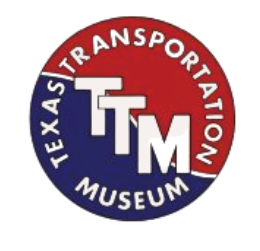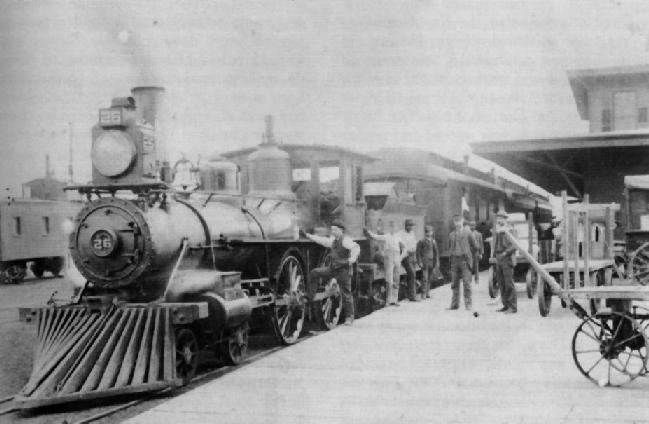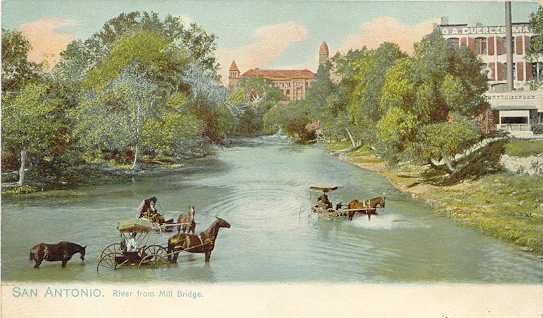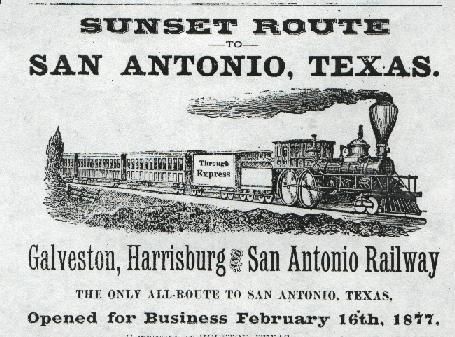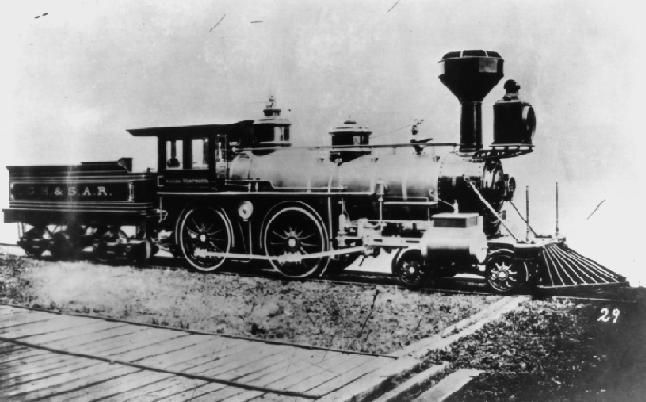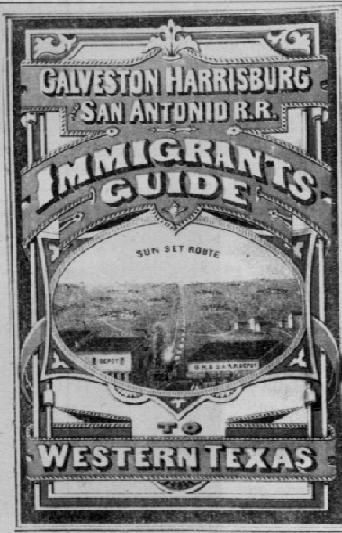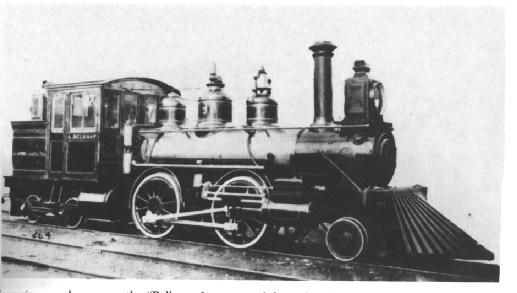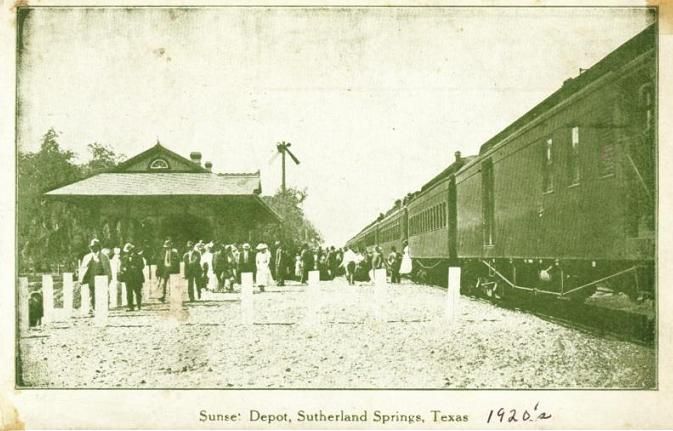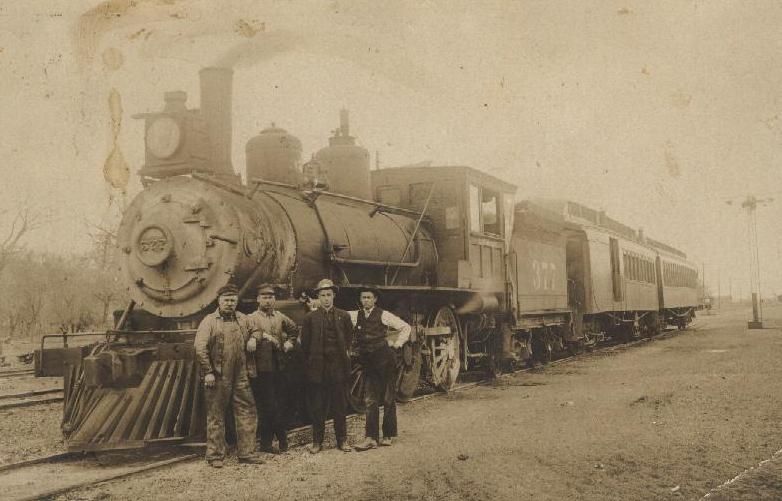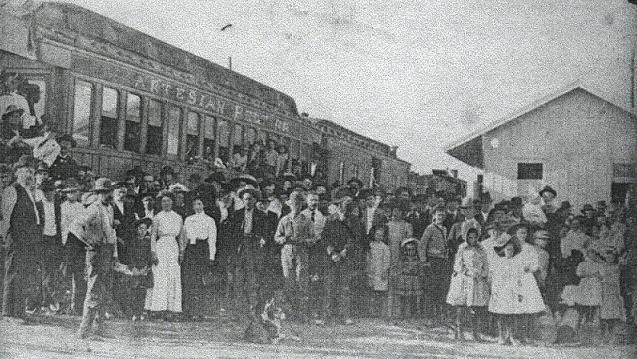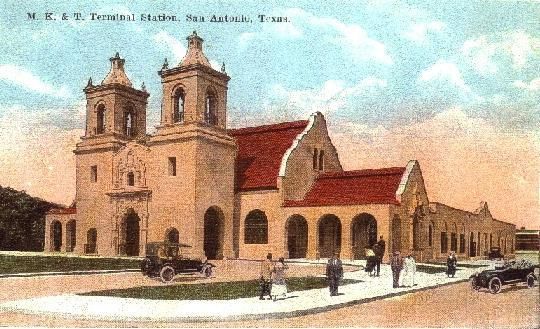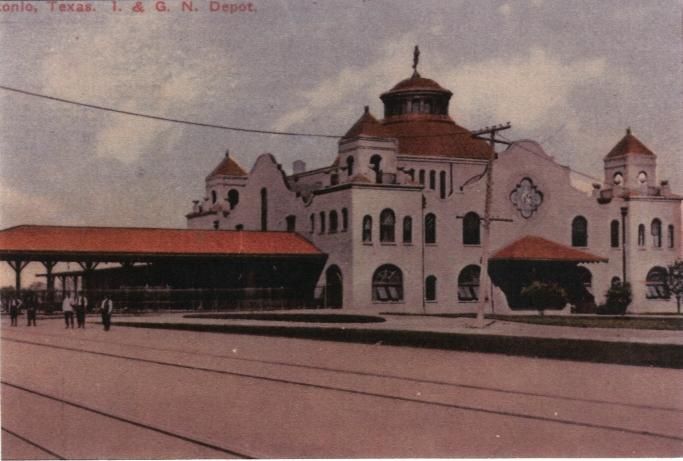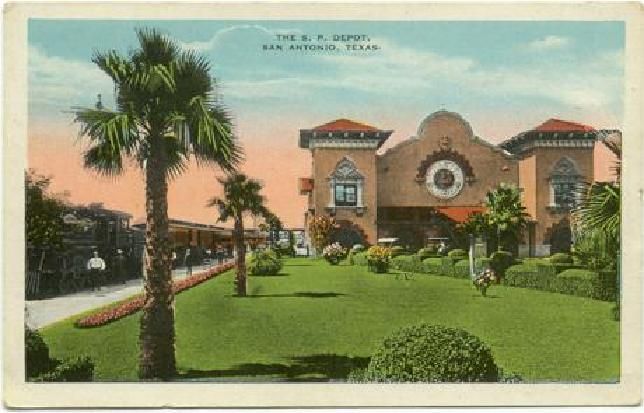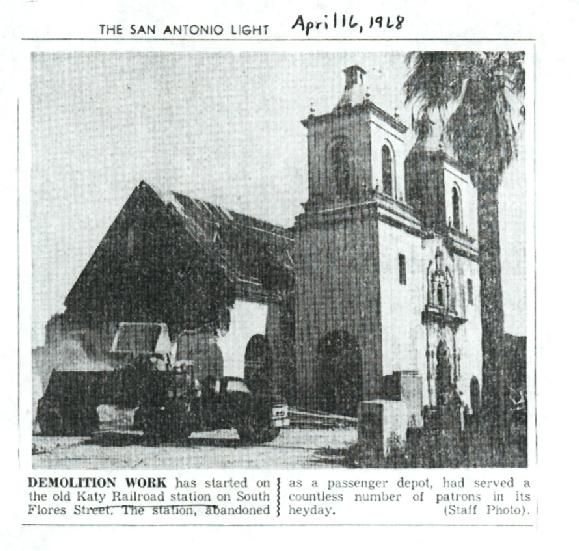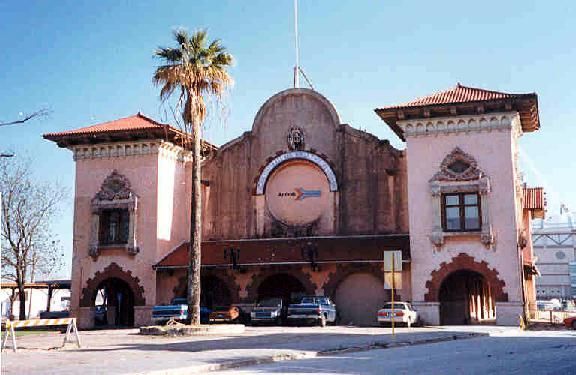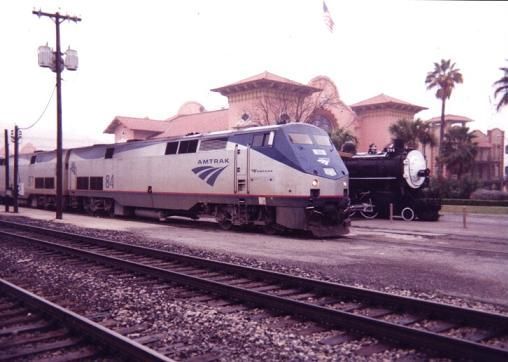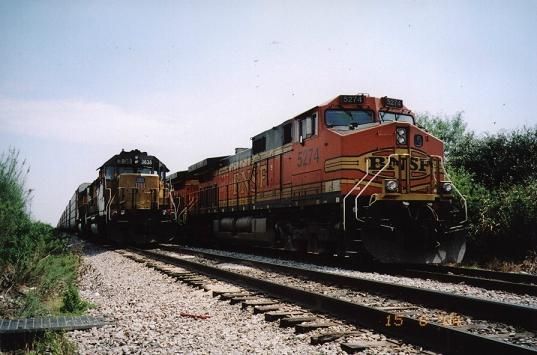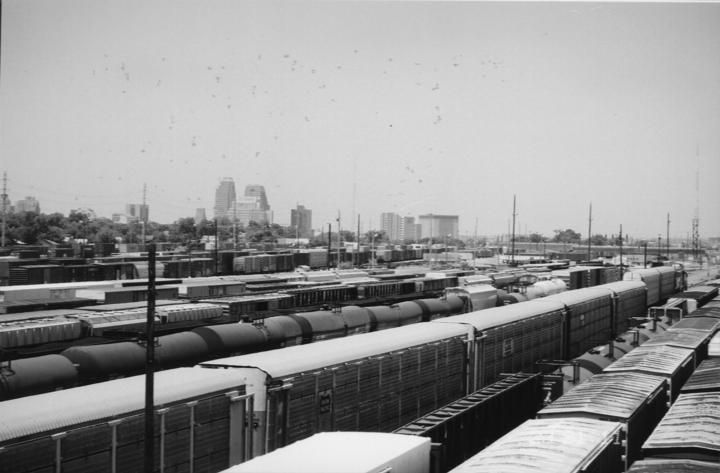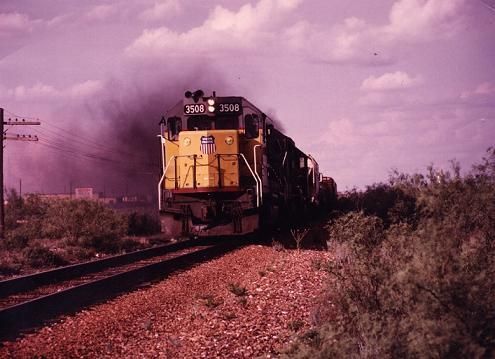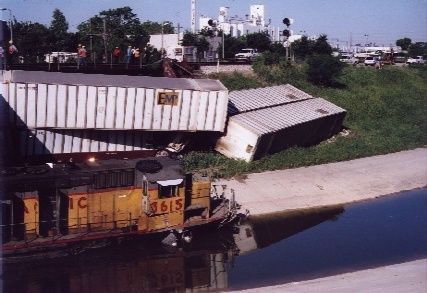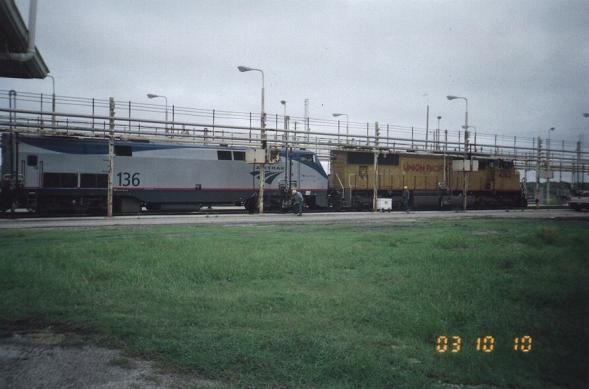San Antonio and the Railroads - An Overview
This page provides an overview of the impact of the railroads upon San Antonio and the surrounding region, including the struggle to achieve these vital connections and the impact they continue to make every day in our lives. The other railroad history pages on this web site focus on the seven original companies that have served the city and their successors.
Achieving Rail Connections
San Antonio was the last major city in the USA to achieve railroad service. Some commentators with a poor understanding of history and economics attribute this to some kind of conspiracy to keep them out but the truth is a lot more interesting. Simple history and geography played a significant role. Texas was originally settled from the south. San Antonio was founded by the Spanish in 1718 on the banks of a generous, free flowing river at the half way point between the main Rio Grande crossing near modern Eagle Pass and Nacogdoches at the edge of their empire near the border of modern Louisiana. Newly independent Mexico did not enjoy much greater success in settling the northern extreme of their country. When Texas declared independence in 1836, San Antonio was isolated from the ports of Indianola, Port Lavaca and Galveston which took on a much larger role as the gateways to the state. When Texas became the 28th state in the Union ten years later, this trend only intensified.
While coastal areas boomed, San Antonio, situated in the interior of the state, became ever more isolated. The United States army, through a series of forts, had helped to tame the region and make the city secure but its prospects looked dim unless it could achieve better communication with the outside world. Towards that end, in 1850 both the city of San Antonio and the county of Bexar invested $50,000 each ($13 million in modern money) in a bold initiative to build a rail line, to be called the San Antonio and Mexican Gulf Railroad, between both Indianola and Port Lavaca, then vying for the position of biggest port in the state, and San Antonio, a distance of some 130 miles. It took a mule drawn wagon train almost two weeks to make the arduous journey, over primitive roads without a single river bridge. Unfortunately the company was unable to fulfill its promises. By the time the civil war broke out eleven years later in 1861 it had only managed to lay tracks as far as Victoria and even these were pulled up by the Confederates to prevent their use by potential invading Federal forces.
Having unsuccessfully sued in court to get its money back, city leaders, whose hands were full of other issues, such as the outbreak of epidemics and ongoing unrest on the part of displaced northern tribes of native Americans and outlaws looking for less policed areas to operate from, declined to invest precious resources into any further railroad "adventures" until it became clear the city would suffer its biggest loss permanently if no action was taken. When the upstart city of Austin, built to be the state capital because it was felt San Antonio was too exposed to incursions from Mexico, gained a railroad connection in 1871, the army decided to relocate to where it had access to much superior transportation with the port of Galveston. Suitably alarmed, San Antonio leaders approached the recently bankrupt Buffalo Bayou, Brazos and Colorado Railroad, which had built a line almost halfway between Houston and San Antonio – they terminated at Columbus on the wrong side of the Colorado River – and offered them $500,000.00 to extend the tracks to the city.
Renamed the Galveston, Harrisburg and San Antonio Railroad, the company began the extension but cash was too tight to allow for rapid construction. Money from San Antonio followed the by now traditional form of a bonus. The railroad would not get paid until the tracks actually arrived in San Antonio and service began. For this reason the railroad stalled in Luling, a town created by the railroad, in 1874, creating a last opportunity for stage coach services which plied gap with gusto, being capable of traveling the 46 miles in only one day each way. Gradually the railhead came closer and closer. It had reached Seguin by late 1875. Finally, on February 16, 1877, the first passenger train arrived in San Antonio. The tracks terminated at Hays Street. It was the cause of a massive city wide celebration that attracted dignitaries, such as the State Governor, and half the city's population which stood at around 16,000 at the time.
The Impact of the Railroads
Before long a two story wooden depot was completed. A commercial boom sprang up in the area around it, which became known as the Levee, because the tracks had required the construction of a high bank to maintain level. What had been almost valueless scrub land became valuable real estate, with hotels, restaurants, warehouses, and all kinds of services vying for business. Within a year mule drawn streetcars, only made possible when the railroad could bring in the equipment, began service to the area, further increasing not only its value but land all along the route to downtown. The railroad was also able to bring in new building materials such as glass, stone, and steel beams that allowed for the construction of large multi-story structures. Joskes, San Antonio's most famous department store, moved out of a small adobe building into a grand new store on Alamo Plaza in 1978. The city gained new underground water service, again thanks to the railroad's ability to bring in not only the pipes but the equipment to dig up the as yet unpaved streets.
The railroad boom took a leap forward with the arrival of the International & Great Northern in January 1881. Within a year their tracks had reached Laredo. Simultaneously the Galveston, Harrisburg & San Antonio's line, now part of the California based Southern Pacific, was being extended westward towards El Paso. In January of 1883, a connection was made with the line being built eastward and San Antonio became the crossroads of America, with all-weather lines running north and south, from Chicago to Mexico, and east to west, from New Orleans to the Pacific. The army was delighted to return. It developed the quadrangle at what would become Fort Sam Houston only a few blocks from the original GH & SA station at the levee.
The city's population soared. By 1880 it had doubled from its 1870 total to 31,000. By the turn of the century it had reached almost 54,000 and in 1910, still before the automobile era had taken root, it was over 161,000. With the destruction of Galveston, San Antonio claimed the mantle of largest city in Texas, a status it would keep for three decades. At the same time the number of farms in the region quadrupled and production of products from the land, such as beef, wool and cedar posts, climbed right along with the influx of new people. The population of nearby Medina County, served by the Southern Pacific which gave land and paid for a court house in newly created Hondo, jumped from 4,500 in 1880 to 9,000 in 1900.
Local Railroads
Four local independent railroads were created in the area by developers keen to create new towns and increase the value of their land holdings. Building a railroad was simpler, quicker and cheaper than a road, and they were easier to maintain, plus the lack of automobiles and trucks and the necessary infrastructure to support them were obstacles that would not be overcome for decades. The first "local" railroad was the San Antonio and Aransas Pass. It was created in 1884 to allow San Antonio access to a closer port than Galveston, and to bypass the Southern Pacific which it was felt, as a California based company, was neglecting the city in favor of its transcontinental business. Its name came from the most promising port on Corpus Christi Bay at the time but the rails were redirected to the city of Corpus Christi by "savior" investors in that city who rescued the struggling project after it had managed to build as far as Floresville, a town created by the railroad, and then ran out of money.
The next company, the San Antonio and Gulf Shore in 1893 had equal ambition but even less capital. It only managed to make it as far as Stockdale on its way to Victoria. It, along with the San Antonio and Aransas Pass, was scooped up by the Southern Pacific, which extended the tracks to Victoria in 1907, achieving the goal of the 1850 project, the San Antonio and Mexican Gulf, in the process. Both these companies revitalized older communities and established scores of new ones. The San Antonio & Aransas Pass also built into the Hill Country as far as Kerrville. The original plan was to reach San Angelo but this never came to pass.
The ambitions of the Artesian Belt were far more limited. In 1908 the new owner of former ranch land southwest of Pleasanton in Atascosa County wanted to develop it into farms but found no one was interested due to the total lack of even the most primitive roads in the area. So he built a 34 mile spur from the Southern Pacific mainline near Macdona on the western edge of Bexar County which also crossed the International and Great Northern at a location called Kirk. On the way to the new town of Christine, it revitalized Poteet and created the new county seat of Atascosa, Jourdanton, selected by popular vote because it had a railroad connection, unlike nearby Pleasanton, the old county seat just a few miles away. In due course, under a new owner, the name of the company was changed to the San Antonio Southern. Surprisingly it became, due to canny investments and the discovery of oil near Jourdanton, the most profitable short line in Texas.
The last local independent also began with limited objectives. Begun in 1909 as the Crystal City and Uvalde, it was built by land developers who wanted better access to the fertile land in Zavala County which they christened the Winter Garden. Soon Carrizo Springs a little further south in Dimmit County. invested in an extension of the tracks to forestall the loss of its county seat status to the new town of Asherton which was being created by yet another developer who was building a branch line to his new farms and town. Soon fruit and vegetables from the region were gracing dinner tables across the nation. Approached by more developers the railroad built haphazardly towards the east with no real goal in mind except helping to develop more profitable farms and businesses. With money from the Fowler brothers, the tracks crossed the main International and Great Northern line between San Antonio and Laredo towards the new town of Fowlerton. Many other new towns, some which faded very quickly, were established as well. It was around this time that the owners of the CC & U were approached by investors from Corpus Christi who were very unhappy with the service they were (not) getting from the Southern Pacific, who had even withdrawn ships of the Morgan Shipping Line, which the SP had acquired, from the struggling port because it interfered with trade at Galveston and New Orleans. What folks in Corpus Christi wanted most of all was Federal funding to create a deep water port, and with the opposition of the only railroad serving their city, their chances were significantly reduced. To improve their situation, they decided to invest heavily in a new line between the port and San Antonio. These would be operated by the renamed San Antonio, Uvalde & Gulf. The new line, which created more new towns and helped move several county seats, began service in 1914.
Meanwhile, the residents of Fredericksburg , the county seat of Gillespie in the Hill Country, did not give up on the idea of a rail connection, despite terrain so difficult for trains that no private company would contemplate building and operating them. In 1913, twenty-six years after the railroad had reached Kerrville, construction, funded – insufficiently – by popular subscriptions of local business owners and residents, began on twenty-four miles of tracks between Comfort and Fredericksburg which necessitated not only 24 bridges with spans ranging from 2 to 743 feet, but also a 920 tunnel as well, one of only six built in Texas. By only 1914 the company had fallen into acrimonious bankruptcy from which emerged the "Fredericksburg & Northern" in 1917. This operation managed to keep going, despite making almost no revenue let alone profit, until it was abandoned in 1942. Long saddled with the loss making line to Kerrville, the Southern Pacific only showed the briefest interest in acquiring the line.
Consolidation and Development
With the completion of the SA&FN the era of railroad construction in San Antonio was over. In 1917 the Missouri, Kansas and Texas opened its own grand station at the corner of Flores and Durango. It had previously used both the International and Great Northern station until it built its own tracks into the city in 1901 and began sharing Sunset Station, for a time known as Union Station, with the Southern Pacific. The SP had acquired the Galveston, Harrisburg and San Antonio in 1881 and opened Sunset Station in 1901. It acquired the San Antonio and Aransas Pass, bankrupted after accidents caused by shoddy construction, in 1890. Its former depot at the corner of Flores and South Alamo Street, originally named Aransas, was used as an officer's club during World War One and was used as a furniture store among other things until it was torn down in 1939. The SP also acquired the San Antonio and Gulf Shore, which did not last long enough independently to build a station in the city.
The Missouri Pacific did not officially buy the International and Great Northern until 1924 after successfully suing in court to rescind its acquisition in a bankruptcy proceeding by the Frisco and Rock Island which then toyed, again, with the idea of building its own tracks into San Antonio. In fact the MK&T acquired the land for its depot from them a decade earlier. MOPAC then purchased the San Antonio, Uvalde and Gulf in 1925 and the San Antonio Southern in 1927.
Boasting three majestic temples of transportation in the form of highly styled railroad stations, and with a plethora of spur lines to each major military installation and any number of industries, the 1920s was the golden age of railroading in San Antonio, as indeed it was in the rest of the nation. Ironically the railroads even served its competitors. It brought in automobiles, trucks and buses, the fuel to run them plus actively assisted the construction of most main roads in the region which were built close to the tracks for ease of delivery of materials and machinery. But in time, as roads and automobiles, buses and trucks improved, fewer and fewer people used trains for local transportation. The big three, the SP, MOPAC and the MK&T, never offered commuter services, even from places like San Marcos, New Braunfels and Boerne, which had yet to become, for all intents and purposes, dormitories, or exurbs, for folks willing to pay the price in time and money to work in the city but live in smaller surrounding communities.
Increasing Competition from Cars and Trucks
It has been said many times that while railroad made their reputations moving people, they made their money moving freight. But even as the number of passengers began to decline, it was becoming cheaper and easier to move "LCL" (Less than Car Load) freight by trucks. As refrigerated vehicles were introduced, farmers began moving sensitive crops by road as well. When the meat packing industry decentralized, it became more economic to move livestock by truck as well. Recognizing this, and seeing other cost advantages, railroads started up large scale trucking operations of their own. They also lobbied heavily for "farm to market" roads to be given higher priority over highway construction and in this they were quite successful, especially in Texas where politicians could brag about how many federal dollars they were bringing into their districts.
World War Two was the last hurrah for passenger transportation by rail but it also soured people on using them ever again after it was over. Under maintained and overcrowded, much like the bus system which suffered a similar fate, people flocked in droves to privately owned automobiles. At the same time most rural communities had been drained of their populations as war work was concentrated in big cities. People associated fading small towns with the Great Depression and nobody wanted that again. One by one small depots began to close followed, quite often, by the complete abandonment of the branch lines that served them. As travel by air improved following the rapid development of larger, safer aircraft and radar guidance systems during the war, the railroads even lost their hold on long distance travel. The glorious city rail stations grew quieter.
The death knell for the Katy, or MK&T, came with the loss of mail contracts to road haulage in 1967. Before long, its already neglected station was abandoned. Finding no buyers, it was torn down and replaced with a hotel, with hardly a single reminder of the location's fifty years as a railroad terminal. MOPAC abandoned passenger service in 1970. While it maintained a massive freight yard, the station was sold to a speculator who found it very difficult to sell to a new tenant. It lay idle, open and visibly deteriorated for 15 years until, almost miraculously, a local credit union stepped up and restored the structure using most of its original railroad themes and adornments, winning San Antonio's first ever prizes for such skillful and sensitive restoration work in the process.
Commercial Railroads Quit the Passenger Business
In 1971 the Southern Pacific, much to its relief – it had petitioned the government for years to be relieved of its passenger train obligations – was able to transfer the oldest continuously operated train in the USA, the "Sunset Limited" to the newly formed AMTRAK, along with the once glorious but now seriously faded Sunset Station, a large payment of money, and all its remaining passenger rolling stock including locomotives. The huge station, and its upkeep, were too much for the ever cash strapped AMTRAK which only operates one daily train – MOPAC's "Texas Eagle," which runs to Chicago, and the "Sunset Limited" which runs three times a week in each direction between New Orleans on the Gulf of Mexico and Los Angeles.
In 1995, with the station in poor condition, including the very poorly executed installation of air-conditioning, which involved the construction of a false front interior wall and the destruction of the huge iconic SP "tracks-into-the setting-sun" stained glass window, AMTRAK was asked to move out by the historic structures new owners, VIA Transit, the county owned bus company, and build a depot more suitable for its more humble requirements. This new depot built with tasteful reference to the old station next door, continues to serve the city. In the meantime, "Sunset Station" itself was completely renovated, at great expense and with remarkable attention to detail, and re-opened as an entertainment complex. That this has not fared as well as originally hoped is no fault of its backers, but more because of its location on the wrong side of the freeway and on edge of the east side where many people simply fear to go.
All the while, despite everything, freight business continued to grow. And one by one all the railroads serving San Antonio were absorbed by the Union Pacific. The Missouri Pacific merged with the UP in 1980. The MK& T was taken over wholesale in 1988. Finally, even the once mighty Southern Pacific was acquired in 1996. As part of the deal, government regulators insisted that the other huge railroad conglomerate, the Burlington, Northern and Santa Fe, be allowed trackage rights on precisely defined lines through the city. This gave the BNSF the right to move over the tracks owned by the UP and even to serve customers in an attempt to maintain the possibility, if not the reality, of competition between competing railroads.
But by this time the railroads real competition were trucking companies. Both were capable of moving standard sized freight containers but the railroad could do it cheaper, if not faster, especially over long distances. Railroads also focused on large unit trains which carried only one product, such as corn syrup for soda, oil and, of particular importance to San Antonio, coal for its three, and soon to be four, electricity generating power stations at Elmendorf which were accessible by rail on one of the few remaining active sections of the old San Antonio and Aransas Pass tracks.
The Importance of Railroads in San Antonio Today
The importance of good railroad connections and the overwhelming importance placed upon trackage rights by railroad companies came to the fore when Toyota announced in 2002 that San Antonio was in the running for a major boost to its economy in the form of a vehicle manufacturing plant providing more than one railroad was able to service the complex, which would be built not far from the old San Antonio, Uvalde and Gulf mainline between San Antonio and Corpus Christi. However the BNSF was not entitled to use these tracks under the terms of the 1996 agreement and the UP simply refused to countenance extending the privilege despite the potential cost to the city. Negotiation by screaming headlines and threats by city leaders yielded no movement from the UP. The exact details of what sweeteners were offered to the railroad conglomerate by the city and state, and possibly Toyota, were never disclosed but in the end the UP did allow the BNSF limited trackage rights to the factory, but certainly not any further towards Corpus Christi, and the plant was built in San Antonio after all.
After a series of tragic accidents and incidents in several San Antonio locations in 2004, the UP has managed to improve its operations to the point where they have become all but invisible except to those living close to the increasingly busy tracks and freight yards in San Antonio. To streamline their operations a vast, $100 million, state of the art intermodal freight yard was opened on the southwest edge of the city in 2009. Otherwise as far as the railroad is concerned, no news is good news.
While freight totals to, from and through San Antonio continue to climb, taxing the almost 140 year old network to its limits, advocates for the return of passenger rail service eye the UP's tracks hungrily. They dream of somehow moving all the freight traffic onto yet to be built – or paid for – tracks far away from the old routes which go through the hearts of so many communities, freeing the old lines for the creation of high frequency commuter trains and high speed inter-city rail service. While some of these plans are quite advanced and have received official blessing in the form of government money to develop the ideas further, the truly vast amounts of money required and the disruption to existing freight service are of such size and complexity to thwart even the most ardent supporters - so far!
San Antonio Railroad Timeline
━━━━━━━━━━━━━━━━━
1850
San Antonio and Bexar County invest $50,000 each in the San Antonio & Mexican Gulf Railroad to reach the port of Indianola
━━━━━━━━━━━━━━━━━
1877
Galveston Harrisburg & San Antonio Railroad (GH&SA) arrives in San Antonio from Houston
━━━━━━━━━━━━━━━━━
1878
Mule drawn street car service is introduced.
━━━━━━━━━━━━━━━━━
1881
International & Great Northern Railroad (I&GN) arrives in San Antonio from the north then reaches Laredo.
━━━━━━━━━━━━━━━━━
1883
Southern Pacific Railroad (SP) begins transcontinental service along the Sunset Route.
━━━━━━━━━━━━━━━━━
1884
San Antonio & Aransas Pass Railroad (SA&AP) is formed to reach Corpus Christi Bay.
━━━━━━━━━━━━━━━━━
1886
SA&AP reaches Floresville and later the port of Corpus Christi.
━━━━━━━━━━━━━━━━━
1887
SA&AP heads north and reaches Boerne.
━━━━━━━━━━━━━━━━━
1888
Missouri–Kansas–Texas Railroad (M-K-T) breaks free of Jay Gould's Missouri Pacific Railroad (MP).
I&GN lease to M-K-T is voided and stays under Jay Gould's control.
━━━━━━━━━━━━━━━━━
1889
GH&SA officially leased to the SP.
━━━━━━━━━━━━━━━━━
1892
SP takes effective control of the SA&AP.
━━━━━━━━━━━━━━━━━
1893
San Antonio & Gulf Shore Railroad (SA&GS) is formed, reaches Sutherland Springs same year.
━━━━━━━━━━━━━━━━━
1894
The “Sunset Limited” train is created by the S.P.
━━━━━━━━━━━━━━━━━
1895
Southern Pacific (SP) acquires the bankrupt SA&GS, renames it San Antonio & Gulf SA&G
━━━━━━━━━━━━━━━━━
1901
M-K-T completed its own line into San Antonio, uses the SP Depot.
━━━━━━━━━━━━━━━━━
1903
SP opens its new Sunset Depot.
━━━━━━━━━━━━━━━━━
1907
I&GN opens grand new station.
━━━━━━━━━━━━━━━━━
1908
Artesian Belt Railroad is completed and serves Jourdanton and Christine.
━━━━━━━━━━━━━━━━━
1909
Crystal City & Uvalde Railroad is created.
━━━━━━━━━━━━━━━━━
1912
San Antonio Uvalde & Gulf Railroad (SAU&G) is new name of expanded Crystal City Railroad.
Worst locomotive boiler explosion in US history happens at Southern Pacific round house.
━━━━━━━━━━━━━━━━━
1913
San Antonio Fredericksburg & Northern Railroad opens between Comfort and Fredericksburg.
━━━━━━━━━━━━━━━━━
1914
SAU&G begins service to Corpus Christi.
━━━━━━━━━━━━━━━━━
1915
The I&GN “Sunshine Special” is inaugurated.
━━━━━━━━━━━━━━━━━
1916
M-K-T opens express freight depot on St. Mary's.
━━━━━━━━━━━━━━━━━
1917
M-K-T opens its own passenger depot at Durango and Flores.
Fredericksburg & Northern Railroad takes over from San Antonio Fredericksburg & Northern Railroad.
━━━━━━━━━━━━━━━━━
1920
San Antonio Southern Railroad (SAS) is the new name of the Artesian Belt Railroad.
━━━━━━━━━━━━━━━━━
1921
Uvalde & Northern Railroad begins operations as a logging railroad to Camp Wood from Uvalde.
━━━━━━━━━━━━━━━━━
1924
Missouri Pacific Railroad (MP) acquires I&GN.
━━━━━━━━━━━━━━━━━
1925
SAU&G is acquired by MP, folded into its Gulf Coast Lines division.
SA&AP is formally acquired by SP. Tracks downgraded to secondary status.
━━━━━━━━━━━━━━━━━
1926
MP opens Monte Vista Depot.
━━━━━━━━━━━━━━━━━
1927
SAS is acquired by MP, folded into its Gulf Coast Lines division.
GH&SA is folded into the SP’s Texas & New Orleans Division.
━━━━━━━━━━━━━━━━━
1930
25 passenger trains enter and 25 leave San Antonio every day.
━━━━━━━━━━━━━━━━━
1934
SA&AP operations folded into the SP’s Texas & New Orleans division.
━━━━━━━━━━━━━━━━━
1939
Original SA&AP Depot is demolished.
━━━━━━━━━━━━━━━━━
1941
18 passenger trains a day enter and 18 leave San Antonio every day.
Uvalde & Northern Railroad ceases operations.
━━━━━━━━━━━━━━━━━
1942
San Antonio Fredericksburg & Northern Railroad ceases operations.
━━━━━━━━━━━━━━━━━
1946
Old SA&AP line between Shiner and Lockhart removed.
━━━━━━━━━━━━━━━━━
1947
M-K-T introduces diesel-electric powered “Texas Special” streamliner train.
━━━━━━━━━━━━━━━━━
1948
MP introduces the Texas Eagle streamliner, replacing the steam powered Sunshine Special.
━━━━━━━━━━━━━━━━━
1950
The SP begin using diesels to power the Sunset Limited.
━━━━━━━━━━━━━━━━━
1952
Local passenger service on former SA&AP and SA&GS lines are terminated by SP.
━━━━━━━━━━━━━━━━━
1955
MP folds I&GN & Gulf Coast Railroad lines operations under its own name.
MP retires its last steam locomotive.
Service ends along former SA&GS line between San Antonio & Sutherland Springs.
━━━━━━━━━━━━━━━━━
1957
SP donates “Old 794,” 2-8-0 Mikado steam locomotive to the city of San Antonio.
━━━━━━━━━━━━━━━━━
1958
Last SP passenger train stops at Hondo
━━━━━━━━━━━━━━━━━
1959
All local passenger services have been discontinued by MP & SP.
Former SAU&G tracks from Pleasanton to Gardendale are pulled up.
━━━━━━━━━━━━━━━━━
1961
Texas & New Orleans division folded into SP.
Last MP train stops at Monte Vista Depot.
━━━━━━━━━━━━━━━━━
1964
M-K-T ceases passenger operations to San Antonio.
Texas Transportation Museum opens at Pearl Brewery using Texas Transportation Company line.
━━━━━━━━━━━━━━━━━
1965
Former SAS tracks to Jourdanton pulled up.
SP obliged to end service to Corpus Christi due to removal of bascule bridge.
━━━━━━━━━━━━━━━━━
1968
Texas Transportation Museum relocates to Northeast Preserve, now known as McAllister Park.
━━━━━━━━━━━━━━━━━
1969
M-K-T depot is demolished.
Converse depot escapes demolition and moves to its new home at Texas Transportation Museum.
━━━━━━━━━━━━━━━━━
1970
Last MP passenger train to San Antonio. Depot is abandoned.
SP reduces frequency of “Sunset Limited” to three times a week.
━━━━━━━━━━━━━━━━━
1971
AMTRAK begins operations and continues the SP’s “Sunset Limited”.
Former SA&AP tracks to Boerne and beyond pulled up north of Camp Stanley.
━━━━━━━━━━━━━━━━━
1973
AMTRAK introduces its new “Inter-American” train from Chicago and New York to Laredo with aspirations of connections further into Mexico
━━━━━━━━━━━━━━━━━
1976
MP tears down its depot in San Marcos.
━━━━━━━━━━━━━━━━━
1982
Union Pacific Railroad (UP) merges with MP.
Abandoned San Antonio MP Depot acquired and restored by San Antonio City Employees FCU
━━━━━━━━━━━━━━━━━
1986
M-K-T light freight depot on St Mary's demolished.
━━━━━━━━━━━━━━━━━
1988
UP buys M-K-T. Sloan yard abandoned
━━━━━━━━━━━━━━━━━
1996
UP merges with SP.
Burlington Northern Santa Fe Railroad (BNSF) gains limited trackage rights through San Antonio.
AMTRAK moved out of Sunset Station into temporary offices as renovation of station begins.
━━━━━━━━━━━━━━━━━
1997
MP is formally merged into UP and disappears.
━━━━━━━━━━━━━━━━━
1998
Former SA&AP line to Floresville pulled up south of Elmendorf.
━━━━━━━━━━━━━━━━━
1999
Fully renovated Sunset Station opens as an entertainment complex.
AMTRAK opens smaller depot adjacent to Sunset Station.
━━━━━━━━━━━━━━━━━
2000
AMTRAK reinstates daily service on its “Texas Eagle” service.
━━━━━━━━━━━━━━━━━
2002
UP causes uproar by refusing BNSF access to proposed new Toyota plant.
━━━━━━━━━━━━━━━━━
2003
BNSF granted trackage rights from San Antonio to new Toyota plant, but not to Corpus Christi.
━━━━━━━━━━━━━━━━━
2004
Six major railroad accidents occur in San Antonio, resulting in five deaths
━━━━━━━━━━━━━━━━━
2005
UP begins $54 million of track improvement in and around San Antonio
━━━━━━━━━━━━━━━━━
2009
UP opens state of the art intermodal freight yard in southwest San Antonio
Frank Crothers at the San Antonio bicycle race track.
Transportation Museum
CONTACT US TODAY
Phone:
210-490-3554 (Only on Weekends)
Email:
info@txtm.org
Physical Address
11731 Wetmore Rd.
San Antonio TX 78247
Please Contact Us for Our Mailing Address
All Rights Reserved | Texas Transportation Museum
